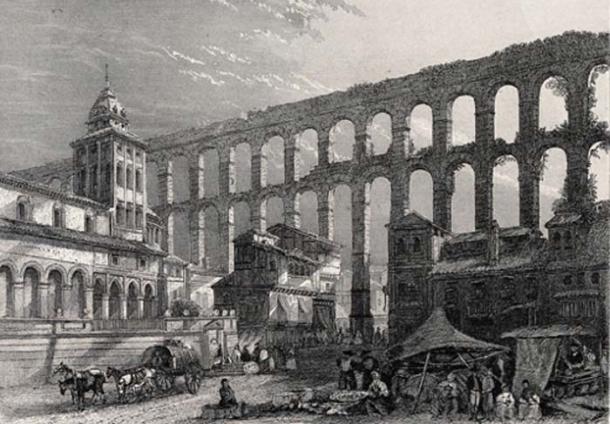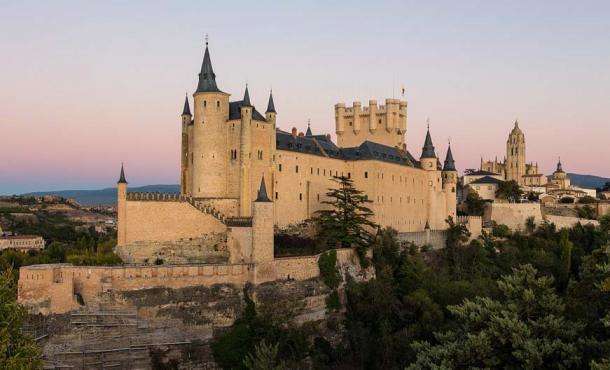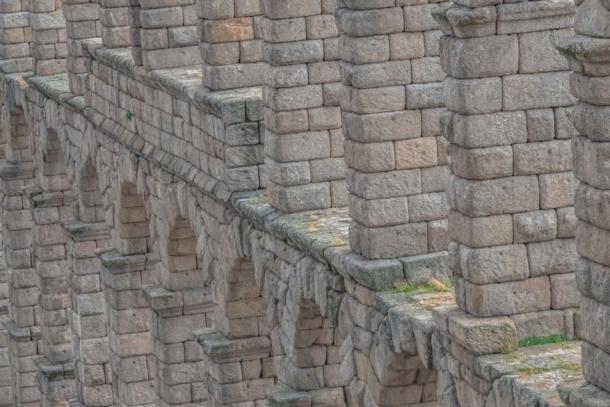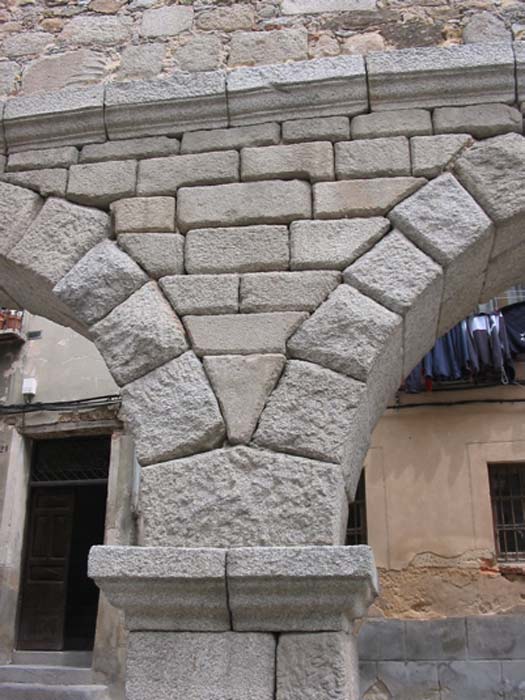
The Lifegiving Aqueduct of Segovia, a Glorious Roman Heritage
When it comes to the great achievements of architecture, the Romans are among the greatest builders of the world’s history. The legacy that they left behind them is an unprecedented glimpse into the origins of modern construction, and it became a stepping stone into the iconic medieval building methods that we know today.
Some of the surviving Roman buildings and monuments are breathtaking, even now, many centuries after they were built. And one of such creations is the famed Roman Aqueduct of Segovia, in Spain. This monumental creation continues to stand firm, almost 2,000 years after its completion, and is as astonishing as it was on the first day.
It truly is a testament to the highly advanced skills of the Roman builders, and an important insight into the secrets of constructing such a complex creation. Join us today, as we marvel at the architectural legacy of Romans and revisit the magnificent Segovia aqueduct.
In the Heart of Spain – The Aqueduct of Segovia Through the Ages
The historic city of Segovia is located in north-western central Spain, in the autonomous region of Castile and Leon. This important city is rich in history and sights, as it is located on an important trading route between Merida and Zaragossa.

The Roman Aqueduct of Segovia, in the historical city of Segovia, Spain. (Fæ / CC BY-SA 4.0)
In ancient history, this was an important Celtiberian settlement, which then passed into the Roman’s hands. Located on a steep and isolated hill, built typically at the junction of two rivers, Segovia was located on the main road between two important roman settlements of Caesaraugusta and Emerita.
This gave it importance and influenced its rapid expansion in Roman times. But even though it was never as large as the aforementioned towns, Segovia was still populated enough to warrant a creation of an aqueduct which would supply the town with water. It was also necessary due to the lack of fresh water springs in the vicinity because of the largely granite and rocky landscape in this part of the country.
The exact period of the creation of this aqueduct was never determined with 100% accuracy. As it lacks any crucial inscriptions to help with dating it, the creation was for a long time a highly debated subject among historians. What everyone did agree on, was a general timeline of 1st century AD. This places the construction period during the reigns of Roman emperors Domitian, Trajan, and Nerva.
In the late 20th century, one researcher came forward with important research to help put an exact date of creation. This was Mr. Alföldy, a famous historian from Hungary. He based this research on the study of bronze anchors.
These are the only remains of a large inscription that once stood on the bridge of the aqueduct. The inscription was made from large bronze letters, which have been missing for a very long time. By studying these remaining anchors that held them, Alföldy managed to piece out the possible message that once stood there. It went as follows:
IMP NERVAE TRAIANVS CAES AVG GERM P M TR P II CO S II PATRIS PATRIAE IVSSV
P. MVMMIVS MVMMIANVS ET P. FABIVS TAVRVS IIVIRI MVNIC FL SEGOVIESIVM
AQVAM RESTITVERVNT
Once translated, the message states:
“By the order of Emperor Nerva Trajan Caesar Augustus Germanicus, Pontifex Maximus, holder of the tribunician power for the second time, father of the country – Publius Mummius Mummianus and Publius Fabius Taurus, co-magistrates of the Flavian municipality of the Segovians, restored the aqueduct.”
This places it around 100 AD, but judging by the inscription, which indicates the repairs carried out on the order of Trajan, the actual construction could have been started earlier, in the time of Emperor Domitian. But either way, most scholars agree that the birth of the Aqueduct of Segovia dates on earlier than the 1st century AD.
A Monumental Achievement – The Segovia Aqueduct In Detail
The actual waterway system of the Segovia aqueduct is close to 10.6 miles (17 kilometers) long. It was designed to carry water from the closest freshwater source - the Rio Frío - which is located in the mountains of Sierra de Guadarrama.
From this river, the Roman built channels that would carry water through the rolling hilly landscape all the way to Segovia and the overlooking castle of Alcázar. The castle itself was built in the 12th century.
- Examining the Impressive Ancient Roman Walls of Lugo
- The Tunnel of Eupalinos: One of the Greatest Engineering Achievements of the Classical World
- The sophisticated water technologies of the ancient Nabataeans

The Aqueduct of Segovia overlooks the castle of Alcázar. (Rafesmar / CC BY-SA 4.0)
As it traverses those 10.6 miles (17 kilometers), the fresh water passes through mostly pastoral meadows, and a few copses of trees. On its path it flows through several sluices, ducts, settling tanks, and at a few places – underground channels.
When constructing aqueducts, the Romans preferred a spring as the source of water. When compared to a river, springs provided a lesser risk of contamination, and the water was purer. But in the area of Segovia, they had to settle with the Rio Frío as the source.
This source is located at an altitude of 13,509 feet (1255 meters), where the water is diverted into the channel of the beginning of the aqueduct. From there it generally follows the contours of the landscape.
About a half of mile (a kilometer) from the actual city walls of ancient Segovia, the channel was faced with a deep valley. And that’s how the Aqueduct of Segovia came to be. The Romans bridged this gap by creating a two story network of stone arches, which support the portion of a wall above and the waterway.
This aqueduct bridge, which is so famous today, is just a small portion of the entire waterway, roughly 5% of the complete length. The bridge is supported by 118 pillars and 119 arches. Of these arches, 42 are two storied.
The ashlars (finely made square stones) of the raised structure number some 25,000. They were made from local granite stone, and interestingly, were originally constructed without any mortar. The complete aqueduct bridge weighs close to 20,000 tons and contains close to 264,860 cubic feet (7,500 cubic meters) of granite.

The ashlars of the Segovia aqueduct were made from local granite stone. (Luis / Adobe Stock)
All of it was quarried locally, some 3.1 miles (5 kilometers) away from Segovia and transported to the construction site. This is no small feat, once you consider that there are numerous granite blocks that weigh a ton, and the largest block that weights two tons.
The cleaning basins, used to sift the sand from the transported water, are located at several key places along the length of the aqueduct. These were the usual parts of Roman aqueducts and were important for the cleanliness of the water. Since sand was carried from the river source, it threatened to erode the channel itself, and needed to be removed.
These basins caught this sandy sediment by the process of decanting, with the sand remaining on the bottom and clean water continuing on its way. The remaining sand was either flushed out, or in some cases, removed by hand.
One interesting fact about this aqueduct, and the proof that Roman architecture was built to last, is the fact that the Segovia aqueduct was used continuously well after the Romans were gone. It has supplied water almost to the present day.
This is the main reason for the good preservation of the aqueduct bridge and the channel, and it still stands much like it was in the Roman times. Albeit, with a few repairs done to it over the centuries, but without changing any of the original structure.
The first considerable threat that the aqueduct received, was during the reign of Alfonso the VI. In 1072 AD, the Berber Muslim king of Toledo, Yahya ibn Ismail Al-Mamun, attempted to conquer Segovia. In the process it is likely that a portion of the aqueduct suffered damage – around 36 arches. Afterwards, some of the dislocated granite blocks were reused by Alfonso VI for the strengthening of his castle.
The damaged arches were reconstructed - as accurately as was possible – during the rule of Isabella I of Castile y León – around 1483. Today, these repairs can be distinguished by the slightly pointed arches – a feature typical of the repair period.

Restored portion of the Segovia aqueduct. (Dodo / CC BY-SA 3.0)
The repairs and preservation was continued afterwards, step by step, during the 16th, 17th, and 18th centuries. Some more drastic measures meant that the original Roman construction was done away with. There was also the rapid expansion of the population of Segovia to consider.
Several homes and buildings were erected right adjacent to the aqueduct bridge, and the location, which was used as a central market zone, further threatened the stability of the structure. This resulted in the demolition of all the buildings built around it – in 1803 and 1806 respectively.
The Modern Threats to an Ancient Structure
But even well into the 19th and 20th centuries, the modernization of the town of Segovia and the onset of motorized traffic , all threatened the survival of the aqueduct, even though it was named the “Monumento Histórico Artístico de carácter nacional” in 1941 and brought into the UNESCO World Heritage list in 1985 alongside the entire old town of Segovia.
The location was the place of a busy traffic intersection, and vehicles passed in several lanes between the ancient Roman arches. The officials even proposed the demolition and removal of one of the central arches in order to ease the flow of traffic.
The traffic was a big threat to the aqueduct, since the vibrations of the many passing vehicles caused cracks and destabilized the structure. During the late 1980’s, engineers implored the public, claiming that the traffic and the continued disregard for the safety of the monument would lead to its imminent collapse.
- Mysterious GodSelf Icon Found Worldwide: Lost Symbol of an Ancient Global Religion?
- Ten Things the Ancients Did Better than Us
- Christians Buried the ‘Immoral’ Theater of Emerita Augusta, But the Grand Monument Would Rise Again

Aqueduct of Segovia as seen from the air. (Jynus / CC BY-SA 2.0)
After this disconcerting alarm, the Council of Europe sent a mission of several chief engineers to determine the actual state of the aqueduct. Several key aspects that contributed to the deterioration were attested, mainly the vehicular pollution that deteriorated the stone, the wind erosion, and the continued vibrations.
This led to the eventual elimination of all traffic beneath and around the bridge, in 1992. After this achievement, the administrative council of Castille y León embarked on a dedicated preservation campaign, undertaking many crucial endeavors that would prolong the life of this national treasure of Spain.
Along the entire 10.6 mile (17 kilometer) course of the Segovian aqueduct, many portions remain fully or partially visible to everyone. At the source, at the altitude of 13,509 feet (1255 meters) in Sierra de Guaderrama, lies the preserved Roman caption – the granite block construction that channels the Rio Aceveda, a small mountain stream and the tributary of Rio Frio, into the further channel of the aqueduct.
This source is made from large granite blocks, and contains the groove for a sluice gate, which was used by the Romans. The whole caption remains one of the best preserved of its type.
Further along, there are many portions of the original Roman channel remaining. Some are open, while others are protected by granite cover stones. There are also small granite bridges, such as the one crossing the little brook Valdeconejos, which was cleverly constructed to divert the water from the brook into the aqueduct channel above.
Another remaining structure, which is only partially of original Roman construction, is the large water cleaning building in Segovia itself. Known as “El Caserón”, this big building served as the basin for decanting the sand from the water. It contains the 6.6 foot (2 meter) deep basin for sand, which would be flushed through a side channel.
The water continues on its course further away, to the second basin building known as the “Casa de Aqua”. This is a slightly larger and deeper basin, without a flushing channel. All of these remnants are important insights into the construction methods and the general anatomy of a Roman aqueduct.
Aqueduct of Segovia Withstanding the Test of Time
The Aqueduct of Segovia stands out in the landscape – a monumental, incredible creation of monolithic proportions. It dominates the town of Segovia and stands as an unshakable testament to the far reaching Roman Empire and their grand achievements. It is also one of the best preserved Roman creations on the Iberian Peninsula, and certainly one of the most famous ones.

The Aqueduct of Segovia stands out in the landscape and is one of the most magnificent works of the Romans on the peninsula. (Antonio Marín Segovia / CC BY-SA 2.0)
Since 1273, it was also a symbol of Segovia and a part of their coat of arms. This tells us that this important water source was highly praised for its entire “lifetime”. And thanks to the continued efforts of the activists that fight for its preservation, this immortal Roman monument will continue to inspire all the generations that will dwell in its titanic shadow.
Top image: The Aqueduct of Segovia, Castilla y Leon, Spain. Source: herraez / Adobe Stock.
References
Gräf. 2015. Segovia Transcription. Epigraphic Database Heidelberg.
Paaschier, C. 2007. Segovia. [Online] Available at: http://www.romanaqueducts.info/aquasite/segovia/index.html
Schuster A. 2016. The Quest to Save Segovia Aqueduct. World Monuments Fund. [Online] Available at: https://www.wmf.org/sites/default/files/article/pdfs/the_quest_to_save_segovia_aqueduct.pdf















